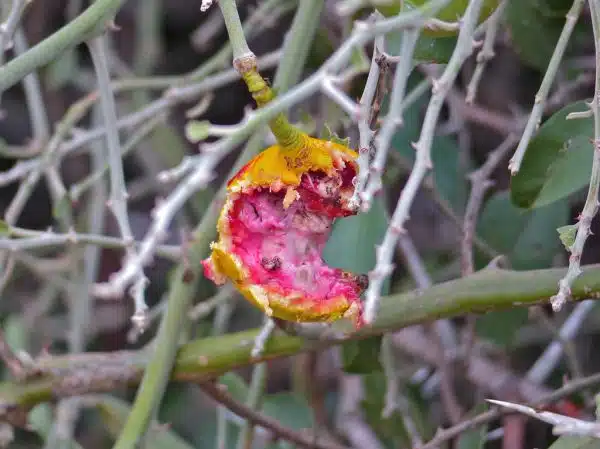The caper bush, also known as Capparis spinosa, is a small, spiny shrub that belongs to the Capparaceae family. Originating in the Mediterranean region, this plant has been cultivated for centuries for its edible flower buds and fruits. The caper bush is a hardy plant that can adapt to various growing conditions, making it an ideal choice for gardeners looking to add some diversity to their landscape.
In this comprehensive guide, we will explore everything you need to know about caring for and growing your very own caper bush. From soil requirements and watering needs to pruning techniques and pest management strategies, we will cover all the essential aspects of cultivating a thriving caper bush. Whether you are a seasoned gardener or just starting out, our guide will provide you with practical tips and expert advice on how to grow healthy and productive caper bushes. So let’s dive in and discover the beauty and benefits of this remarkable plant!
Overview Of The Caper Bush
The caper bush, known as the prickly perennial, is a plant that has long been popular for its unique flavor and aroma. This plant is native to the Mediterranean region and can be found growing in rocky areas or on walls. The caper bush produces small, white flowers that are followed by green berries. It is from these berries that the well-known capers are harvested.
The caper bush has been used for centuries in Mediterranean cuisine and is a staple ingredient in many dishes. The flavor of the caper berry is salty, tangy, and slightly bitter, making it an excellent addition to salads, sauces, and marinades. The leaves of this plant are also used in cooking and have a more delicate flavor than the berries.
Growing caper bushes requires specific conditions such as full sun exposure and well-draining soil. This plant can tolerate drought conditions but does not fare well in frost or freezing temperatures. Caper bushes are typically propagated through cuttings or seeds and require regular pruning to maintain their shape and encourage new growth. In the following section, we will delve into the history and cultivation of this unique plant.
History And Cultivation
The caper bush has been known for its culinary and medicinal uses for centuries. In the previous section, we discussed the overview of the caper bush, including its scientific name, physical features, and benefits. In this section, we will delve into the origins and folklore of this plant, as well as its cultural significance and traditions.
Origins and Folklore: The caper bush is believed to have originated in the Mediterranean region, particularly in areas such as Greece, Italy, and Spain. It has a long history dating back to ancient times when it was used for various purposes such as food preservation, medicine, and even religious rituals. According to Greek mythology, Zeus transformed his lover Caper into a plant after she was unfaithful to him. This legend may have contributed to the plant’s popularity in ancient Greece.
Cultural Significance and Traditions: Throughout history, the caper bush has played an important role in various cultures worldwide. In Italy, capers are used in traditional dishes such as pasta alla puttanesca and vitello tonnato. In Jewish cuisine, capers are an essential ingredient in traditional recipes like lox with cream cheese and bagels. The plant also holds cultural significance in Morocco where it is believed to ward off evil spirits during weddings.
As we can see from these examples, the caper bush is not just a plant with practical uses but also holds cultural significance across different regions. Its rich history has contributed to its popularity today and continues to influence its usage.
Moving forward into our next section about climate and growing zones; it is important to understand how environmental factors affect this plant’s growth.
Climate And Growing Zones
Caper bushes thrive in areas with a mild Mediterranean climate. They prefer to grow in regions with hot and dry summers, and mild winters. These conditions are optimal for the plant’s growth and yield. The ideal temperature range for growing capers is between 50°F and 85°F.
While caper bushes can withstand some frost, they do not tolerate extreme temperatures. Therefore, it is essential to consider the climate constraints when growing these plants. In areas with cold winters or hot summers, it may be necessary to provide some protection from the elements. For example, during winter months, covering the plant with a blanket or burlap wrap can help protect them from frost damage.
When selecting an area for growing capers, ensure that there is plenty of sunlight. These plants require at least six hours of direct sunlight every day to flourish. If grown in shady areas or regions without enough sunshine, their growth will be stunted, and they will produce fewer flowers and fruits. By considering these factors when selecting an ideal region for growing caper bushes, you can ensure a successful harvest each year.
As you choose the right soil for your caper bush plant care & growing guide needs, consider several factors such as soil drainage and quality. To optimize their growth potential, caper bushes require well-draining soil with good nutrient content. Soil that retains too much moisture can lead to root rot and other diseases that may affect plant health and yield. Choosing the right soil type is crucial to ensuring a thriving crop of flavorful capers each season.
Choosing The Right Soil
When choosing the right soil for caper bush plant care and growing, it is important to consider the soil pH and texture. An ideal soil pH for caper bush is 6.0 to 8.0, as this allows for optimal nutrient uptake. Furthermore, the soil texture should be well-draining and loose. This allows for adequate oxygenation, which is essential for healthy root development.
Soil Ph
When it comes to growing caper bushes, the soil pH is an important factor that can greatly affect their growth and development. Testing your soil’s pH level is a crucial step in determining whether it’s suitable for your caper bush or not. Ideally, caper bushes prefer slightly alkaline soil with a pH range of 7.0-8.5.
If your soil’s pH level is too low or acidic, you can improve its pH balance by adding lime, which raises the soil’s alkalinity. On the other hand, if your soil is too alkaline, you can lower its pH level by adding sulfur to increase acidity. However, it’s important to note that adjusting the soil’s pH level should be done gradually and monitored closely to prevent damaging your caper bushes.
To ensure optimal growth and health of your caper bushes, regular testing of your soil’s pH level is necessary. Improving the soil’s pH balance can also benefit other plants growing in your garden as well. By taking care of the soil, you’re not only serving yourself but also serving others by creating a healthy and thriving environment for all plants to grow in harmony.
Soil Texture
Understanding the soil composition is crucial in choosing the right soil for your caper bushes. The texture of the soil can greatly affect the growth and development of your plants. Soil texture refers to the size distribution of mineral particles, such as sand, silt, and clay, that make up the soil. Caper bushes thrive in well-draining soils with a mix of sand, silt, and clay particles.
The ideal soil composition for caper bushes is a loamy soil. Loamy soils are made up of roughly equal amounts of sand, silt, and clay particles. This type of soil provides good drainage while retaining moisture and nutrients necessary for plant growth. However, if your garden has heavy clay or sandy soils, there are techniques you can use to improve drainage and create a suitable growing environment for your caper bushes.
One technique to improve drainage is by adding organic matter like compost or leaf litter to the soil. Organic matter helps break down compacted soils by improving its structure and increasing water infiltration rates. Another technique is raised bed gardening which involves building elevated planting areas filled with a mixture of loamy soil mixed with compost or other organic matter. By improving the texture and drainage capabilities of your garden’s soil, you can create an optimal growing environment for your caper bushes while also benefiting other plants in your garden ecosystem.
Watering Needs And Irrigation
Watering is a crucial aspect of caper bush care as it affects the overall growth and fruit production of the plant. The caper bush is a drought-tolerant plant, but it still requires regular watering for optimal growth. The frequency of watering depends on the weather conditions, soil type, and age of the plant.
Drip irrigation is an effective method for watering caper bushes. This system delivers water directly to the roots, minimizing water loss due to evaporation or runoff. It also allows for consistent moisture levels in the soil. Drip irrigation can be set up using a timer or manual control and can be adjusted based on the specific needs of the plant.
The frequency of watering largely depends on environmental factors such as temperature, humidity, and rainfall. In general, caper bushes require more frequent watering during periods of high heat or drought. However, overwatering should be avoided as it can lead to root rot and other fungal diseases. It is important to monitor the soil moisture level regularly to ensure that it remains moist but not waterlogged.
Moving forward with caper bush care, proper fertilization and nutrient requirements are essential for healthy plant growth and fruit production. By providing adequate nutrients through fertilization, caper bushes can thrive in various growing conditions while producing an abundant yield of flavorful buds.
Fertilization And Nutrient Requirements
Watering is an essential aspect of caper bush plant care. The soil should be kept consistently moist but not waterlogged. Overwatering can lead to root rot, which can severely damage the plant. It is recommended to water deeply once a week during the growing season and reduce watering in winter when the plant is dormant.
Fertilization is another crucial factor in caper bush maintenance. Organic fertilization is preferred over synthetic ones, as it contains natural nutrients that promote healthy growth and development of the plant. Nitrogen-rich fertilizers are particularly beneficial for caper bushes during their growing stage, while phosphorus and potassium are more essential during flowering and fruiting stages.
Nutrient deficiency symptoms can occur if the plant does not receive adequate nutrition. Common signs include yellowing leaves, stunted growth, and reduced flowering or fruiting. In such cases, organic fertilizers can help revive the plant’s health by providing much-needed nutrients to its roots. Regular soil testing can also help identify nutrient deficiencies before they become severe.
Moving forward, understanding how to propagate your caper bush plants will enable you to expand your collection and share them with others. There are several propagation techniques that one may use, including stem cuttings or seed germination. Each method requires careful attention to detail and patience but ultimately results in a new generation of thriving caper bushes ready for cultivation.
Propagation Techniques
To propagate caper bushes, there are two primary techniques: indoor propagation and outdoor propagation. Indoor propagation involves using a heated propagator or a warm windowsill to start the process. The seeds should be sown in a good-quality compost mix, kept moist but not waterlogged, and germinated at around 20°C. Once the seedlings have established roots, they can be transplanted into individual containers.
Outdoor propagation is another method of propagating caper bushes. This technique is ideal for those who want to grow the plant on a larger scale. It involves taking cuttings from an established plant during its dormant period and sticking them in the ground or in pots filled with well-draining soil. The best time to take cuttings is in late autumn or early winter when the plant has lost its leaves.
Both indoor and outdoor propagation methods require patience and attention to detail. It’s essential to keep the soil moist but not waterlogged, provide adequate light, and protect young plants from extreme temperatures or harsh weather conditions. With proper care and maintenance, caper bushes can thrive and produce flavorful buds that are perfect for culinary use.
Moving onto pruning and training techniques, it’s important to know how to maintain your caper bush once it has been propagated successfully.
Pruning And Training
Pruning a caper bush is an important part of its care and maintenance. Different pruning techniques can be used to shape the bush, encourage healthy growth, and remove damaged or diseased branches. Training a caper bush involves controlling its growth and direction, to produce a desired form or shape. This can be done through techniques such as tying the branches, staking, and pruning.
Pruning Techniques
Pruning is an essential aspect of caper bush plant care. It helps the plant to maintain its shape, promote healthy growth, and prevent diseases. The benefits of pruning your caper bush include increasing flower production, promoting stronger stems, and improving air circulation. However, it is crucial to understand the different styles of pruning before you start.
One common technique is pinching or tip pruning. This involves removing the top few inches of new growth using your fingertips or sharp scissors. Pinching promotes branching and encourages the plant to produce more flowers. Another technique is selective pruning, which involves removing specific branches or stems that are damaged or diseased. This method helps to prevent further spread of disease and allows healthy new growth to emerge.
When pruning your caper bush, it’s important to use clean, sharp tools and make cuts at a 45-degree angle just above a leaf node. Avoid cutting too much at once as this can shock the plant and lead to stunted growth. By mastering these techniques and understanding when and how to prune your caper bush correctly, you will keep it healthy and thriving for years to come without much effort on your part.
Training Methods
Pruning is just one aspect of caring for your caper bush. Training methods are another essential element to ensure that your plant grows in the desired shape and form. Two popular techniques used by horticulturalists are Espalier and Topiary artistry. These methods help to create a visually appealing garden while maximizing space.
The Espalier technique involves training the plant to grow flat against a wall, fence, or trellis. This method is ideal for small gardens as it ensures that the plant takes up less space while still producing a bountiful harvest. It also allows for better light penetration, which can lead to increased flower production and prevent fungal diseases.
Topiary artistry involves pruning the caper bush into various shapes such as balls, cones, or spirals. This technique requires patience and skill but can be incredibly rewarding when done correctly. Topiary artistry is an excellent way to add visual interest to your garden and showcase your creativity.
By combining pruning with training methods such as Espalier and Topiary artistry, you can create a beautiful garden filled with healthy caper bushes that produce plenty of flowers and fruit. Remember always to use clean and sharp tools when pruning or training your plants, make cuts at a 45-degree angle just above a leaf node, and avoid cutting too much at once to prevent stunted growth. With these tips in mind, you’ll be able to care for your caper bush like a pro!
Managing Pests And Diseases
After properly pruning and training your caper bush, it’s important to be vigilant in managing pests and diseases. While the caper bush is relatively low-maintenance, it can still fall victim to a variety of common garden pests such as aphids and spider mites. Additionally, fungal diseases such as powdery mildew can also be a concern.
When dealing with pests and diseases, it’s best to start with natural remedies before turning to chemical control options. For example, introducing ladybugs or lacewings into your garden can help control aphid populations without the use of harmful chemicals. Neem oil or insecticidal soap sprays are effective against spider mites while also being safe for beneficial insects like bees.
However, if natural remedies prove ineffective or if the infestation is severe, chemical control may be necessary. Always follow instructions carefully when using pesticides and consider consulting with a professional horticulturist or extension office for guidance on appropriate products and application methods.
Transitioning into harvesting caper buds and fruits, it’s important to note that pest management should continue throughout the growing season in order to ensure a healthy crop. By taking steps to prevent pests and disease early on in the growing process, you’ll have a bountiful harvest of flavorful caper buds and fruits to enjoy throughout the year.
Harvesting Caper Buds And Fruits
- Caper buds and fruits are harvested during the summer and early fall months when the buds are fully formed but not yet opened.
- For the harvesting of caper buds and fruits, a pair of sharp scissors, gloves and a container are essential tools.
- Caper buds and fruits can be preserved in several ways including pickling, freezing and drying.
- To pickle, after harvesting and cleaning the caper buds and fruits, they should be preserved in a vinegar-brine solution for several weeks.
- Freezing is another option for preserving caper buds and fruits. The buds and fruits should be blanched and quickly frozen in air-tight bags.
- Drying is the most common method of preserving caper buds and fruits, as they should be spread in the sun and air-dried until they become crunchy.
Harvesting Season
As a horticulturist and caper bush plant care & growing guide writer, it is essential to understand the harvesting season of this plant. The caper bush yields its buds and fruits during the summertime, typically from May to August. During this period, it is crucial to harvest the buds and fruits when they are at their optimal size and flavor.
To ensure quality post-harvest processing, it is advisable to pick the buds early in the morning before the sun gets too hot. This technique helps retain their freshness and prevent them from becoming damaged during transportation. After harvesting, it is crucial to sort out any damaged or diseased buds and fruits as they can affect the overall quality of the final product.
In conclusion, understanding the harvesting season of caper bushes is vital for ensuring a good yield and high-quality post-harvest processing. As a horticulturist, it is imperative to educate growers on proper harvesting techniques that will help them achieve maximum yield while maintaining high-quality standards. So if you’re looking to grow caper bushes successfully, keep these tips in mind for a bountiful harvest!
Tools Needed
Now that we have discussed the harvesting season of caper bushes, it’s time to talk about the tools needed for harvesting caper buds and fruits. As a horticulturist, it is essential to use the right types of tools and required equipment to ensure a successful harvest. The most common tools used for harvesting caper buds and fruits are pruning shears or scissors.
Pruning shears or scissors are essential tools when it comes to caper bush plant care. They are used to cut the stem below the bud or fruit while leaving a small portion of the stem attached. This technique helps in preserving the quality of the final product by preventing damage to the remaining buds and fruits on the same stem. Other required equipment includes gloves to protect your hands from thorns and prickles, baskets or crates for collecting harvested buds and fruits, and a sharp knife for trimming off any excess stem.
In conclusion, using appropriate tools is crucial when harvesting caper buds and fruits. The use of pruning shears or scissors helps preserve their quality while preventing damage to other buds and fruits on the same stem. As a horticulturist, it is imperative to educate growers on proper harvesting techniques using these types of tools and required equipment. By doing so, they can achieve maximum yield while maintaining high-quality standards in their harvests.
Preservation Techniques
When it comes to harvesting caper buds and fruits, it is not just about cutting them off the stem. Preservation techniques are also crucial in maintaining their quality and flavor. One preservation technique commonly used for caper buds is brining. Brining involves soaking the caper buds in a solution of salt and water, which helps preserve their texture, flavor, and color. This technique can also enhance their taste by reducing bitterness. Once brined, caper buds can be stored in jars with vinegar or oil for later use.
Aside from brining, proper storage of harvested caper buds and fruits is also essential to maintain their quality. Caper bud storage should be done in a cool, dry place away from direct sunlight to prevent them from wilting or molding. It is recommended to store them in an airtight container or glass jar with a lid to keep moisture out. For longer-term storage, they can be frozen or dried.
In conclusion, preserving the quality of harvested caper buds and fruits is vital to ensure that they maintain their flavor and texture. Brining techniques such as soaking them in a saltwater solution help prolong their shelf life while enhancing their taste. Proper storage methods such as keeping them cool, dry, and away from sunlight can also help preserve their quality for future use. As horticulturists, it is essential to educate growers on these preservation techniques so that they can achieve maximum yield while maintaining high-quality standards in their harvests.
Culinary Uses
It’s fascinating to note that the caper bush has been used as a culinary ingredient for over 2000 years. The ancient Greeks and Romans were known to use the preserved flower buds in their dishes, and it remains popular in Mediterranean cuisine today. The caper bush is also grown commercially in parts of Italy, Spain, and France.
The flavor profile of the caper bud is tangy and salty, with a slightly bitter aftertaste. It adds a unique flavor to sauces, dressings, and marinades. Caper buds are often used alongside olives, anchovies, and garlic in traditional Mediterranean dishes. They can be enjoyed raw or cooked using various methods such as pickling or preserving in vinegar.
Capers have also gained popularity among health-conscious individuals due to their high antioxidant content. They are said to have anti-inflammatory properties that may help reduce the risk of chronic diseases such as cancer and heart disease. In the next section, we will explore the medicinal properties of the caper plant further.
Medicinal Properties
Caper bushes are not only valued for their culinary use but also for their medicinal benefits. The caper bush has been used in traditional remedies for centuries due to its therapeutic properties. The plant contains several bioactive compounds that have antioxidant, anti-inflammatory, and antimicrobial effects.
One of the primary medicinal benefits of caper bushes is their ability to lower blood sugar levels. Studies have shown that the plant’s compounds can help regulate glucose metabolism and increase insulin sensitivity, making it a potential treatment for diabetes. Additionally, caper bushes have been used for their anti-inflammatory properties to treat arthritis and other inflammatory conditions.
Caper bushes are also believed to have antimicrobial properties that can help fight off infections caused by bacteria and fungi. The plant has been traditionally used to treat skin infections, such as eczema and psoriasis, as well as respiratory infections like bronchitis and the common cold. These medicinal benefits make caper bushes a valuable addition to any medicinal garden or natural remedy toolkit.
Transitioning into the subsequent section about caper bush varieties, it is important to note that different varieties of the plant may have varying levels of these beneficial compounds. Understanding the differences between caper bush varieties can help determine which one may be best suited for your specific needs or preferences. Let’s take a closer look at some of the most popular varieties and their unique characteristics.
Caper Bush Varieties
Caper bushes are a popular addition to gardens and landscapes, prized for their unique flavor profile and culinary uses. However, not all caper bushes are created equal – there are several varieties of caper bush available, each with its own distinct characteristics.
One of the most common varieties of caper bush is the ‘spinosissima’ variety. This particular type of caper bush is known for its small size and delicate leaves, as well as its strong, earthy flavor profile. Spinossima capers are particularly popular in Italian cuisine, where they are often used in pasta dishes and sauces.
Another popular variety of caper bush is the ‘inermis’ variety. Inermis capers are larger than spinosissima capers and have a milder flavor profile, making them a great option for those who prefer a more subtle taste. These capers are commonly used in Mediterranean cuisine, particularly in dishes like tapenade and salads.
Lastly, the ‘rutidosis’ variety of caper bush is another popular option. This particular type of plant is known for its large leaves and striking yellow flowers, which bloom in the late spring or early summer months. Rutidosis capers have a slightly sweeter flavor profile than other varieties and work well in both sweet and savory dishes.
Overall, choosing the right variety of caper bush can make all the difference when it comes to culinary applications. Whether you’re looking for a bold earthy flavor or a more subdued taste, there’s sure to be a variety that suits your needs perfectly.
Moving on from the various types of caper bushes available to gardeners around the world, let us delve deeper into how these plants can be used in cooking. With their distinctively tangy flavor profile that has been likened to pickles or olives by some people, it’s no surprise that capers have become an essential ingredient across various cuisines. From adding depth to sauces and stews, to being an essential ingredient in Mediterranean dishes like pasta alla puttanesca or a classic Caesar salad, capers have numerous culinary uses. Whether you’re a fan of Italian cuisine, French cooking or just looking to add some variety to your home-cooked meals, the versatility of capers makes them a must-have in any kitchen.
Now that we’ve explored the different varieties of caper bushes and how they are used in cooking, let’s move on to some commonly asked questions about caring for these plants. Understanding the best practices when it comes to growing and maintaining caper bushes is crucial if you want to ensure healthy and fruitful plants. Some of the questions we will be exploring include – What are the ideal growing conditions for caper bushes? How often should you water your plants? And what pests or diseases should you look out for when planting capers? With these answers at your fingertips, you’ll be well on your way to cultivating thriving caper bushes in no time!
Commonly Asked Questions
After exploring the various types of caper bushes available, it’s time to delve into the benefits that this plant can bring. Not only do capers add a delicious tang to dishes, but they also have medicinal uses that have been appreciated for centuries. In ancient times, capers were used as a natural remedy for ailments like rheumatism and inflammatory conditions.
In modern times, research has confirmed that the active compounds in capers possess anti-inflammatory and antioxidant properties that can help combat free radicals in the body. This means that incorporating capers into your diet can help protect against cell damage and inflammation, which are associated with many chronic illnesses such as heart disease and cancer. Additionally, studies have also shown that the high levels of flavonoids in capers may help reduce blood pressure levels.
Aside from their health benefits, caper plants are also relatively easy to grow and care for. They thrive in hot climates with well-draining soil and don’t require much water or fertilizer. However, like any plant, they can still suffer from common issues such as pests or disease. In the next section, we’ll address some frequently asked questions about troubleshooting these problems so that you can grow healthy and bountiful caper plants in your own garden.
Troubleshooting Common Issues
As with any plant, the caper bush is susceptible to a variety of problems. Fortunately, many of these issues can be prevented with proper care and attention. Pest prevention is key when it comes to keeping your caper bush healthy. Insects like aphids and spider mites can wreak havoc on your plant if left unchecked. Regularly inspecting your caper bush for signs of infestation, such as yellowing leaves or cobwebs, is important in catching potential problems early. If you do spot an issue, there are a number of organic insecticides that can help keep pests at bay.
Another common issue that may arise when growing caper bushes is nutrient deficiencies. These plants require well-draining soil and plenty of sunlight to thrive, but they also need a balanced fertilizer regimen to ensure they receive all the nutrients they need. Signs of nutrient deficiencies include yellow or brown leaves, stunted growth, and poor fruit production. To prevent these issues, be sure to provide your caper bush with a high-quality fertilizer that contains all the essential macronutrients and micronutrients.
Overall, maintaining a healthy caper bush requires vigilance and attention to detail. By preventing pests and ensuring your plant receives proper nutrition, you can avoid many common issues that may arise when growing this unique shrub. Remember to always monitor your plant’s growth closely and make adjustments as needed to ensure it stays healthy and productive for years to come.
Frequently Asked Questions
How Long Does It Take For A Caper Bush To Produce Buds?
The caper bush produces buds after several years of growth, and its timing can vary depending on pruning techniques and ideal soil conditions. Pruning techniques, such as removing dead or damaged branches, can promote healthier growth and encourage the plant to produce more buds. Additionally, the ideal soil conditions for a caper bush include well-draining soil with a pH between 7.0 and 8.5. A horticulturalist who specializes in caper bush plant care and growing guide would recommend proper pruning techniques and soil management practices to help the plant reach its full potential. For those with a subconscious desire to serve others through gardening or horticulture, investing time and effort into nurturing a caper bush can ultimately lead to a bountiful harvest of flavorful capers.
Can Caper Bushes Grow In Containers?
Can caper bushes be grown in containers? The answer is yes, caper bushes can be grown in containers provided that the container size is adequate and the soil type is well-draining. It is recommended to use a container with a diameter of at least 18 inches and a depth of 12 inches to ensure enough space for the plant’s roots to grow. A well-draining soil mix consisting of equal parts sand, perlite, and peat moss is ideal for caper bushes grown in containers. However, it is important to note that container-grown caper bushes may require more frequent watering and fertilization as compared to those planted directly in the ground. With proper care, caper bushes can thrive in containers and produce delicious buds for culinary use.
Do Caper Bushes Attract Pests Or Insects?
Natural predation and companion planting are effective ways to prevent pests or insects from attacking caper bushes. Introducing beneficial insects, such as ladybugs or lacewings, can naturally control aphids and whiteflies. Additionally, planting herbs like basil, mint, or lavender near caper bushes can repel harmful pests while attracting beneficial ones that will help control infestations. It is important for horticulturalists to keep a close eye on their caper bushes and regularly inspect them for signs of pest damage. By utilizing natural predation and companion planting techniques, gardeners can maintain healthy caper bushes without the need for harmful pesticides or chemicals.
Are Caper Buds Poisonous If Not Prepared Properly?
Toxicity concerns are a delicate matter when it comes to culinary uses of certain plants. One such example is the caper bud, which can be dangerous if not prepared properly. As a horticulturalist, my recommendation would be to exercise caution when handling the buds and to thoroughly research proper preparation techniques before incorporating them into your dishes. While it’s important to explore new flavors and ingredients in the kitchen, it’s equally important to prioritize safety and responsible consumption practices. Remember, serving others should always come with a commitment to their well-being.
How Much Sunlight Do Caper Bushes Require?
Caper bushes require full sun exposure for optimal growth and development. They thrive in well-draining soil with a pH range of 7.0 to 8.5. It is important to avoid overwatering, as caper bushes prefer dry conditions and are sensitive to water-logged soils. To ensure proper drainage, it is recommended to plant caper bushes in raised beds or containers with adequate drainage holes at the bottom. During the growing season, it is advised to water regularly but sparingly, allowing the soil to dry out between watering sessions. Proper soil requirements and watering tips are crucial factors in successful cultivation of caper bushes, which can provide a bountiful harvest when cared for properly.
Conclusion
The caper bush, also known as Capparis spinosa, is a resilient and versatile plant that can thrive in a variety of environments. While it may take up to three years for the bush to produce buds, it is well worth the wait as these buds are highly valued in Mediterranean cuisine for their unique flavor. Capers can be grown in containers, making them an excellent choice for small gardens or balconies.
As with any plant, caper bushes may attract pests or insects such as aphids or whiteflies. Regular pruning and proper care can help prevent infestations. It is important to note that while caper buds are safe to eat when properly prepared, they should not be consumed raw as they contain toxins.
Caper bushes require full sunlight and well-draining soil. They are drought-resistant and do not require frequent watering. With proper care and attention, the caper bush can provide a bountiful harvest of flavorful buds for many years to come.
In conclusion, growing a caper bush requires patience and care but the reward is well worth it. This resilient plant can thrive in various environments and provides a unique flavor profile that cannot be replicated by any other ingredient. With its ability to grow in containers, the caper bush is an excellent choice for those with limited space or resources. So why not try your hand at growing this versatile plant today? Your taste buds will thank you for it!
Image Credits
- “Woolly Caper Bush (Capparis tomentosa) edible (!) fruit” by berniedup (featured)





























